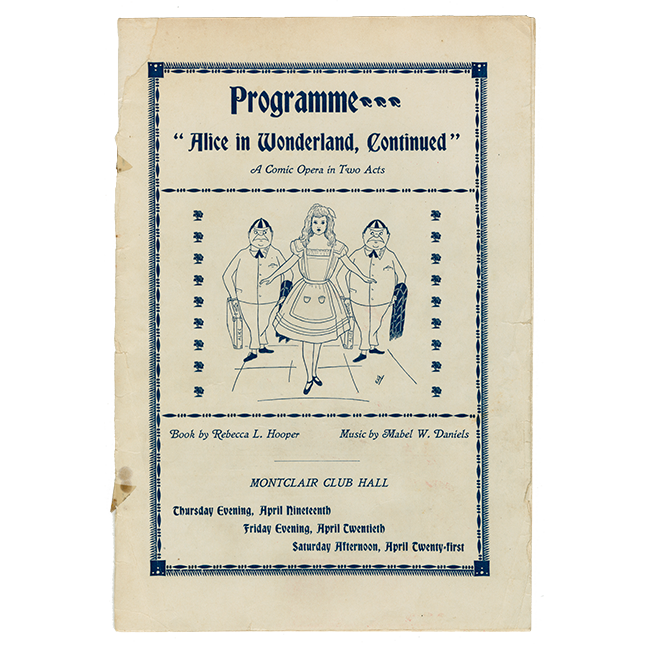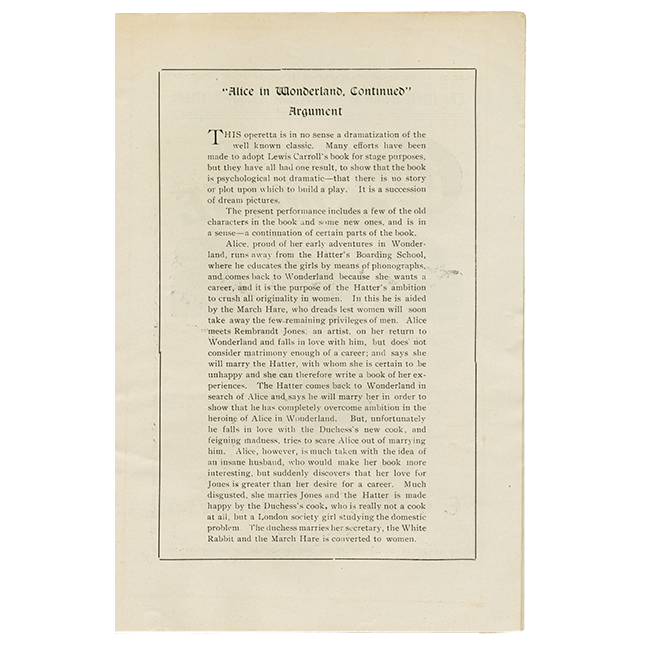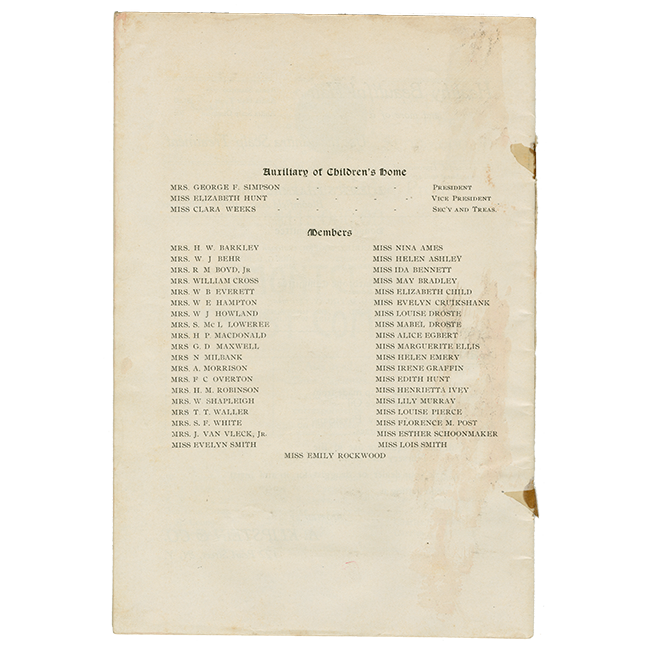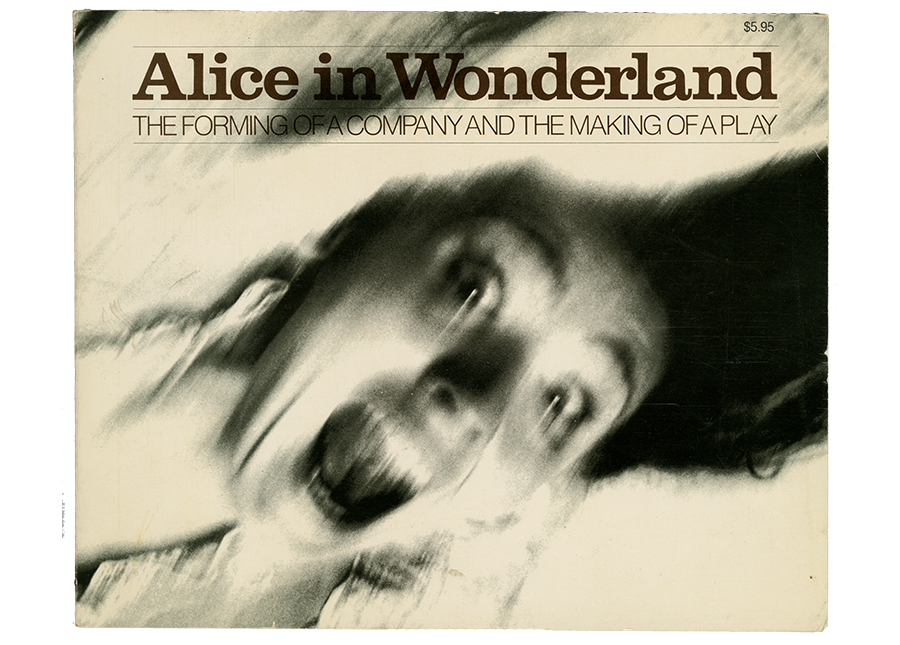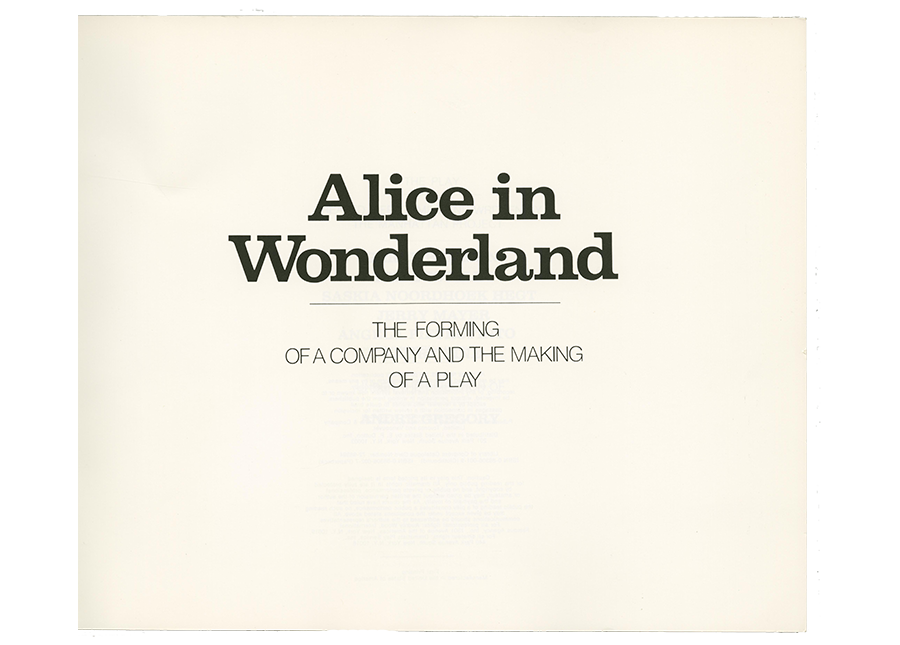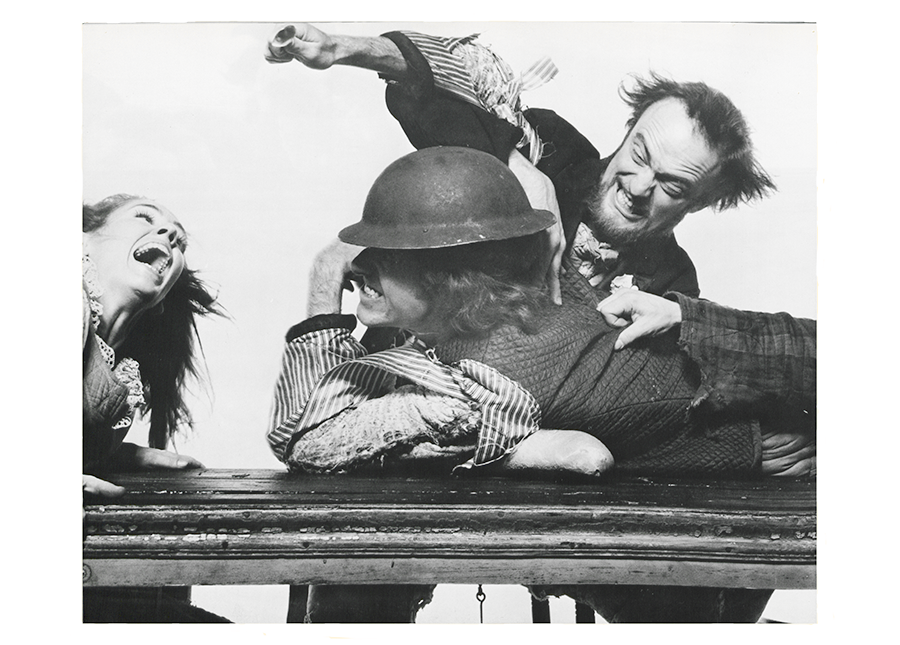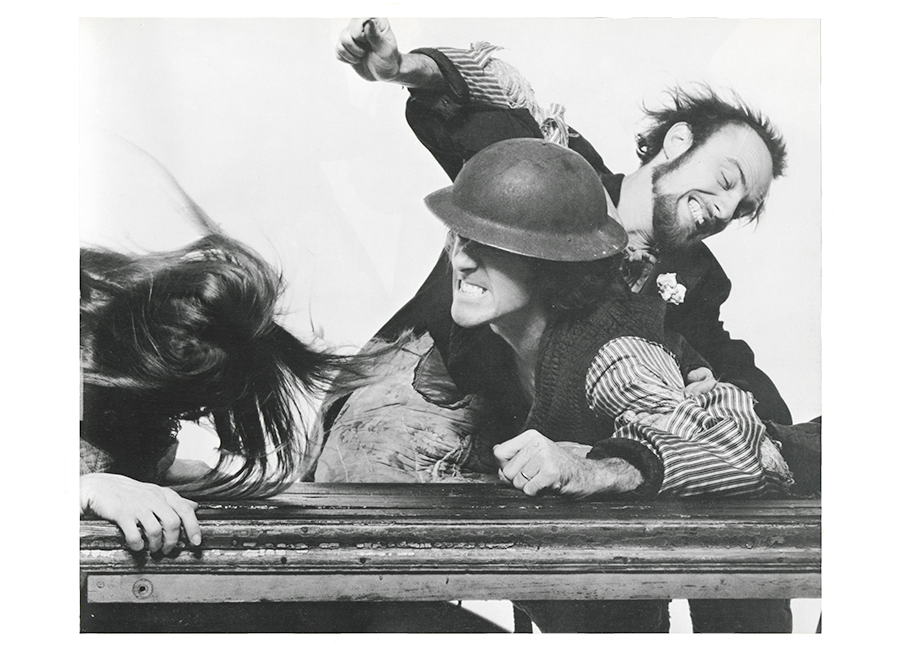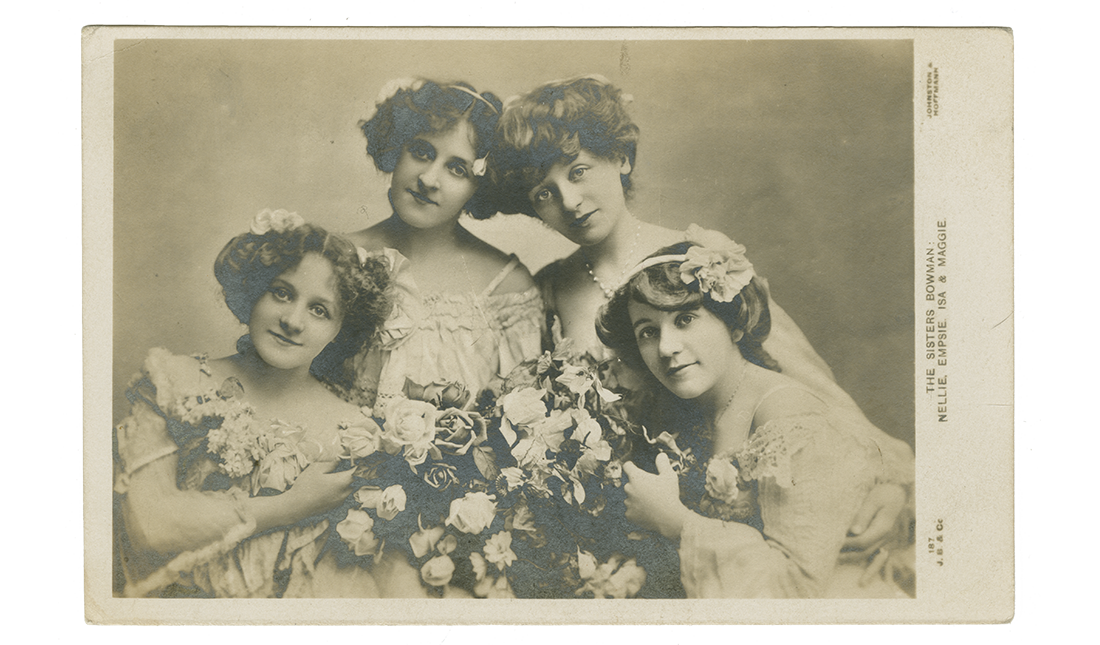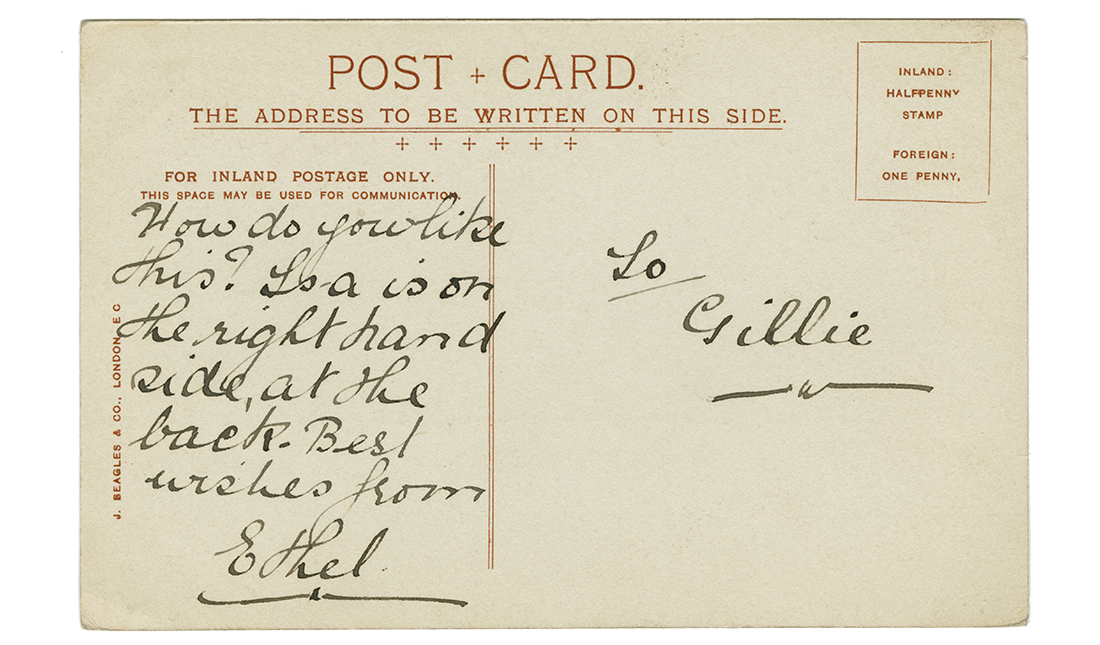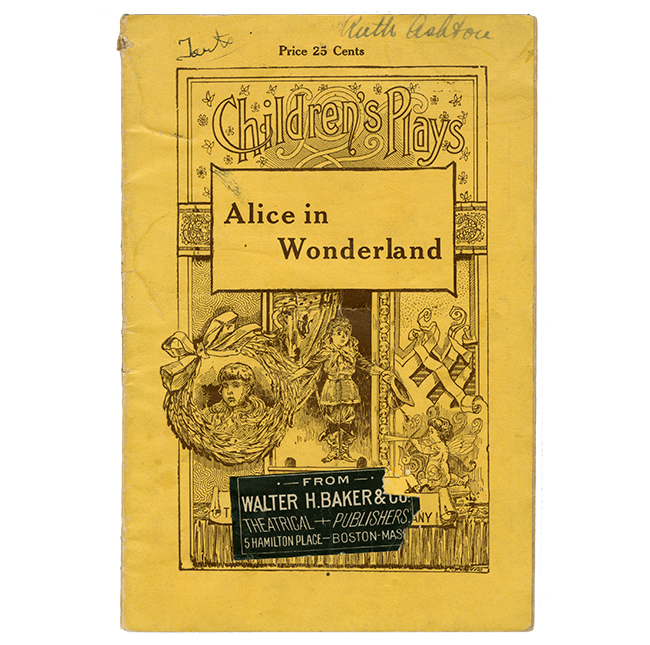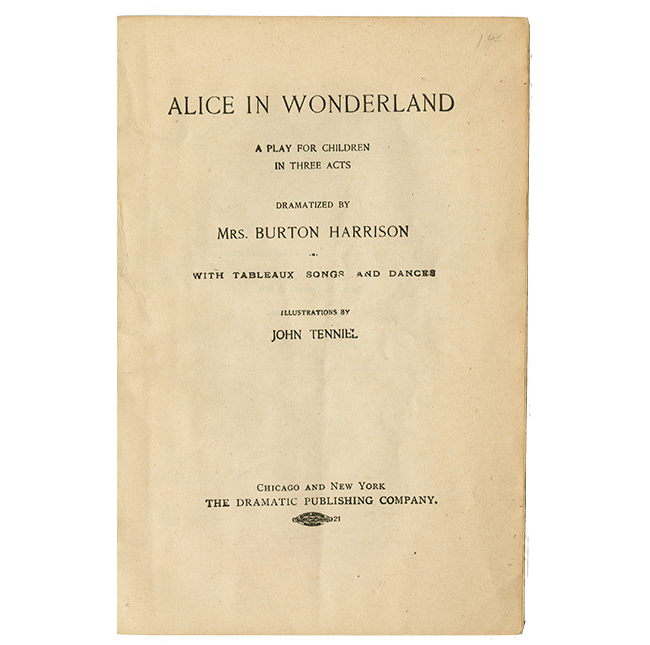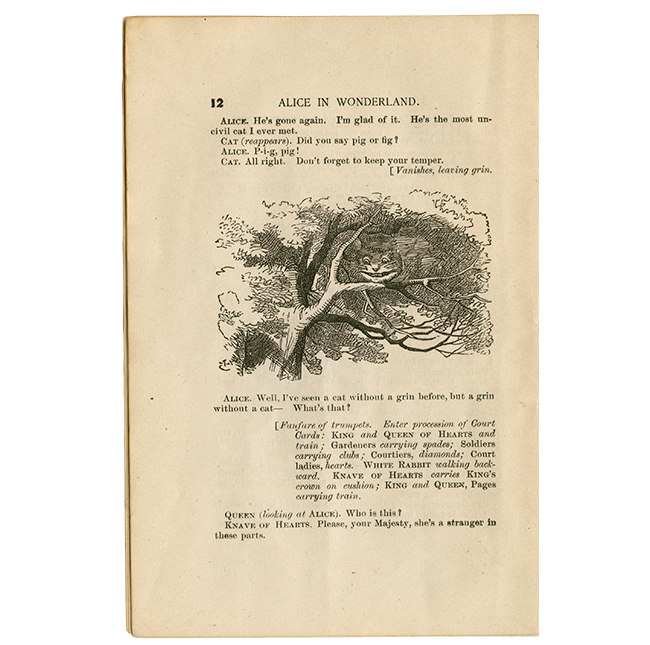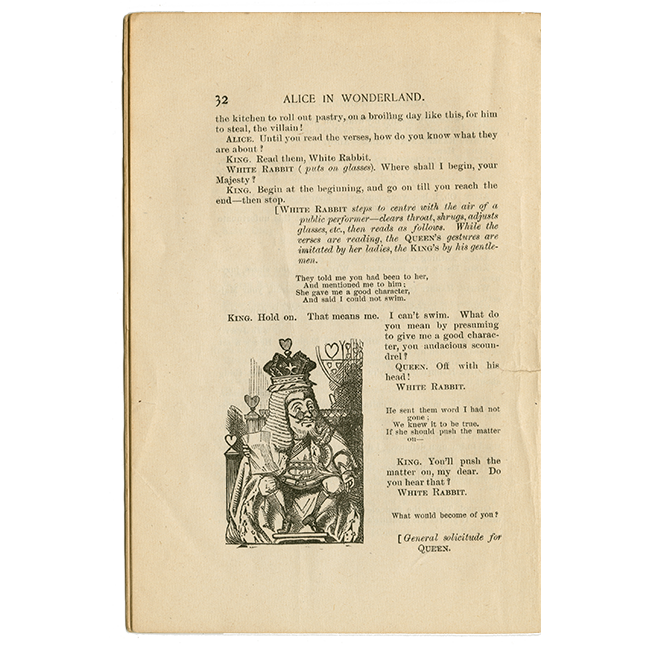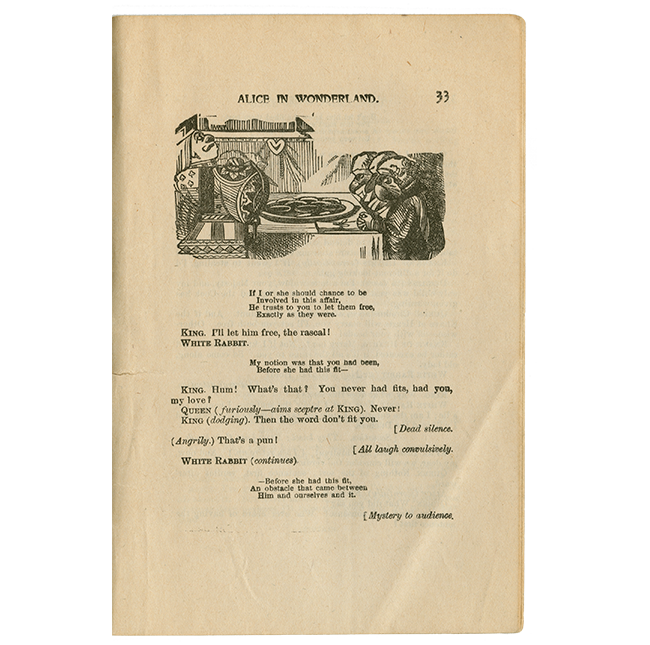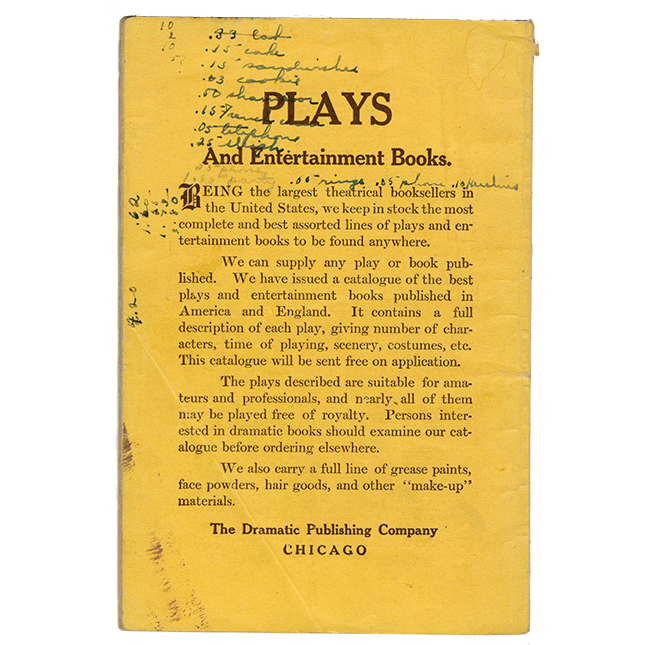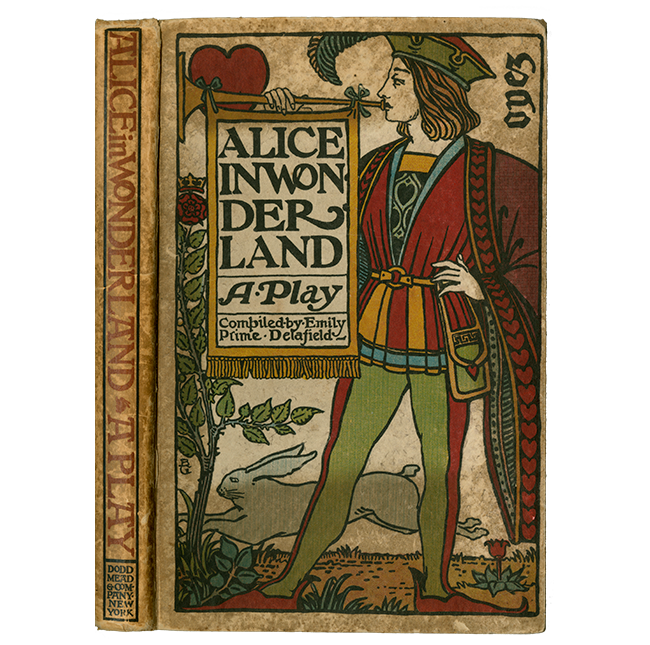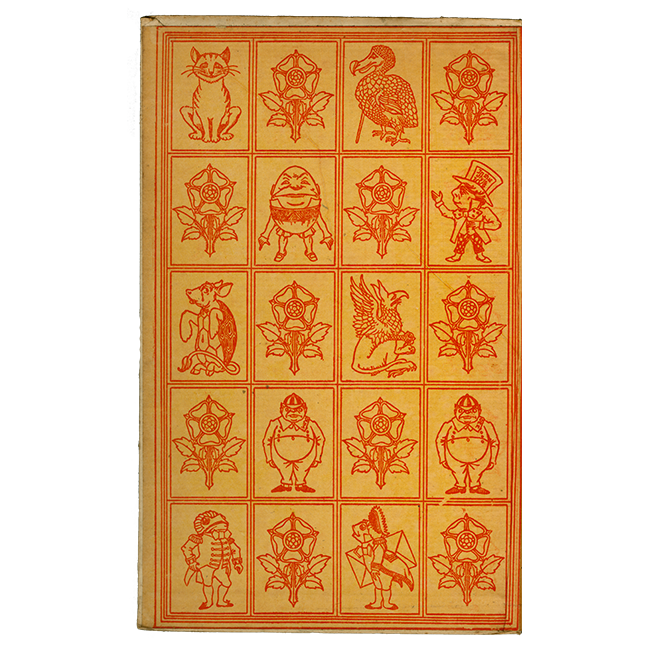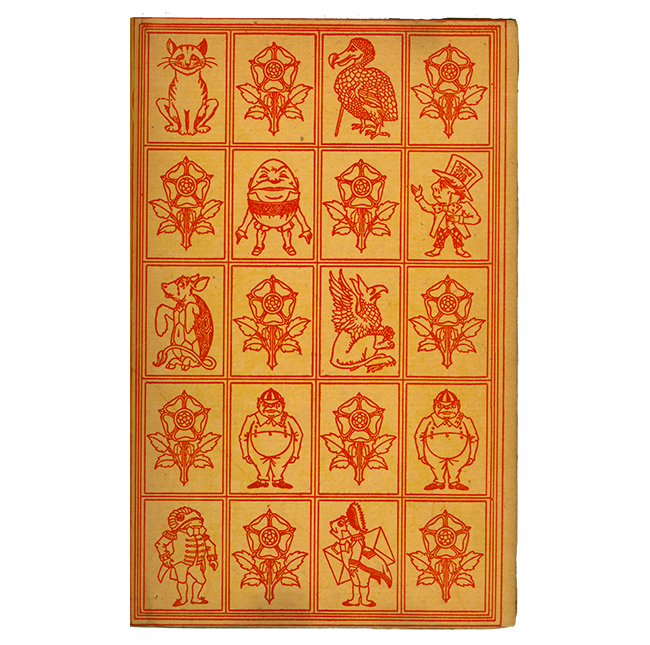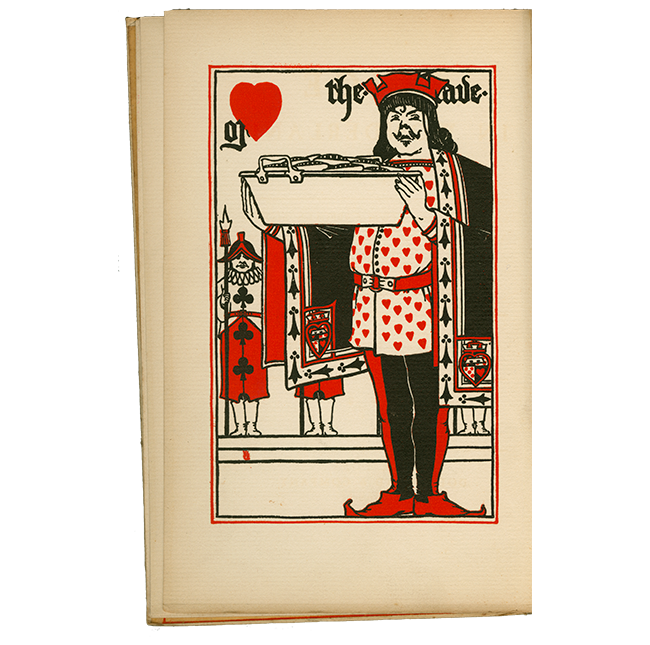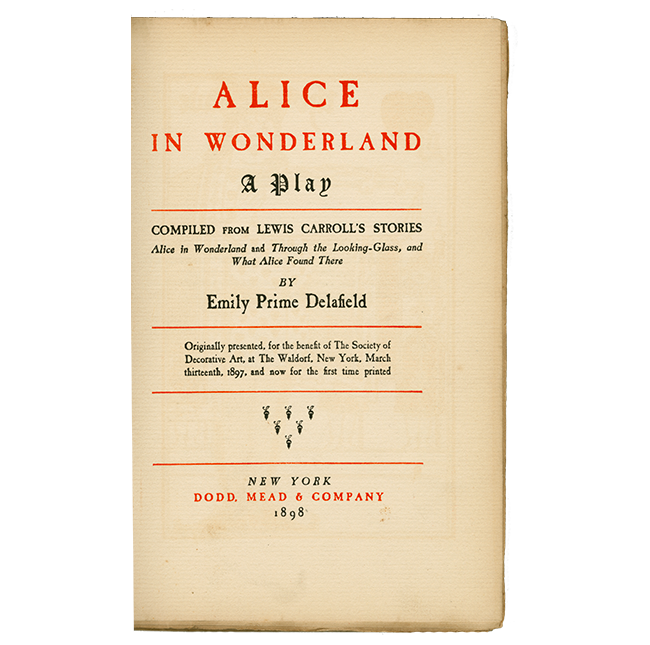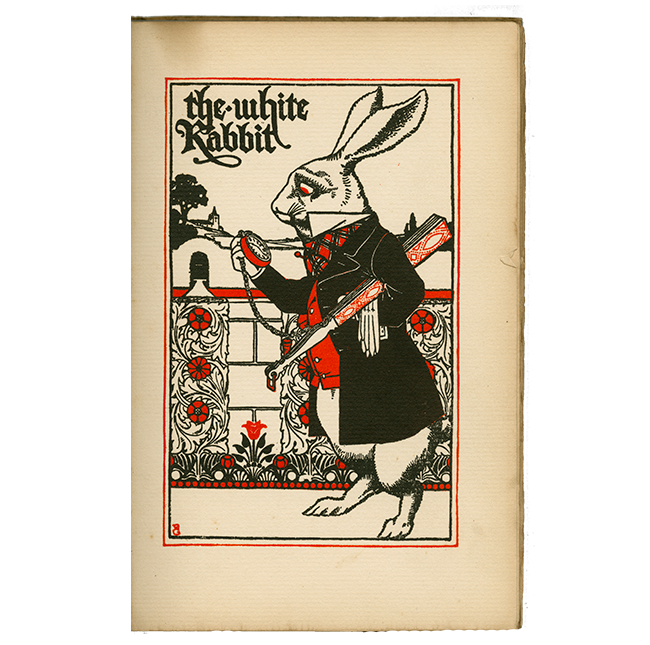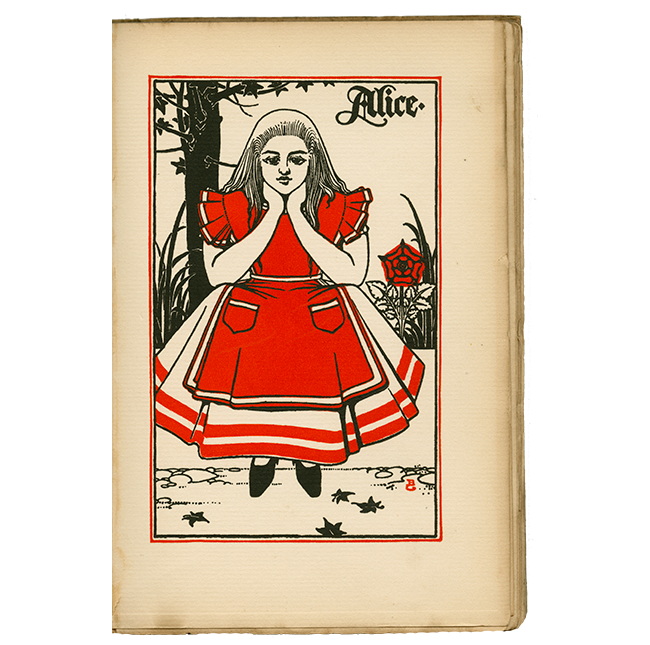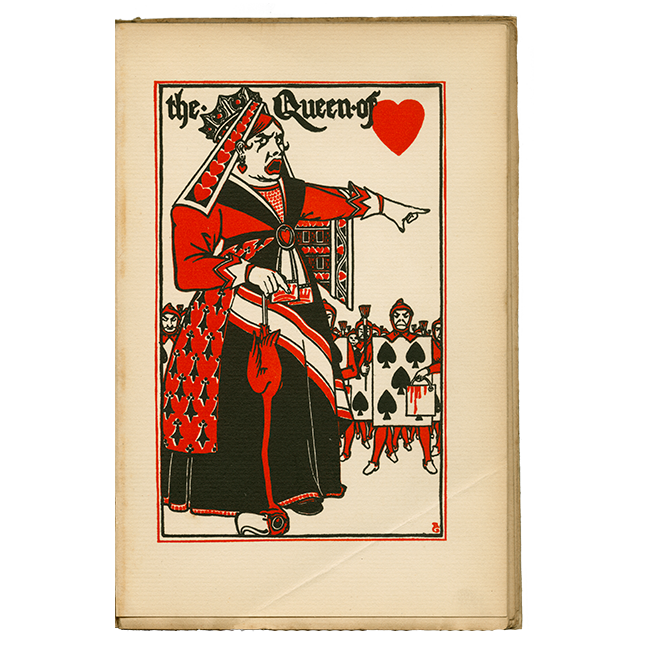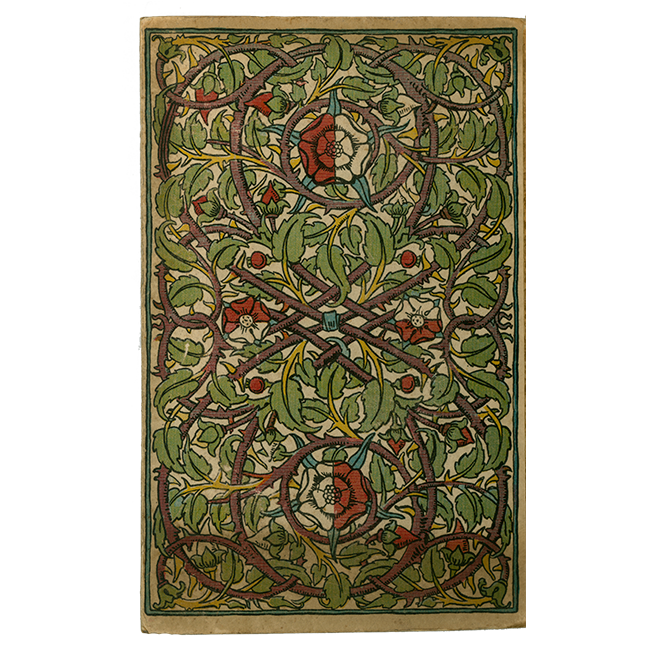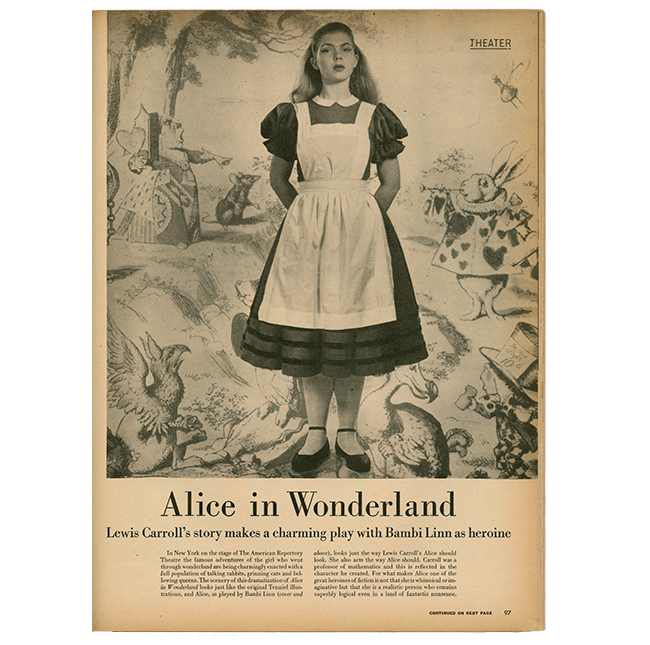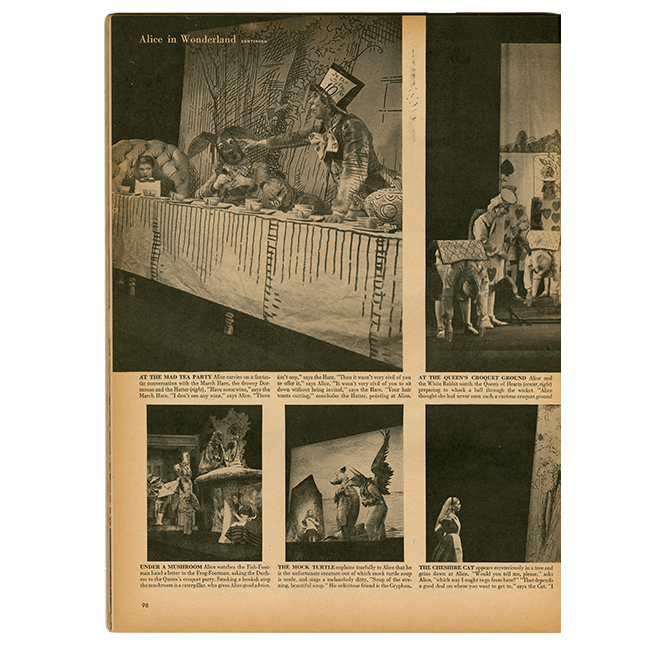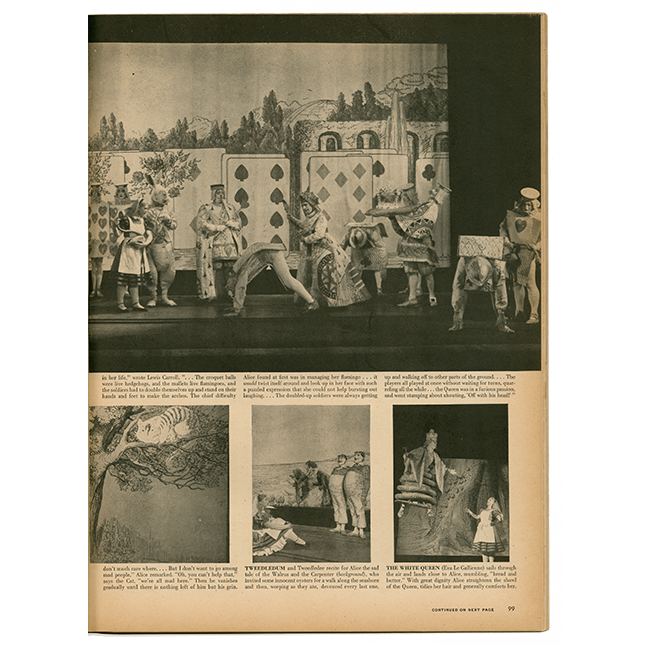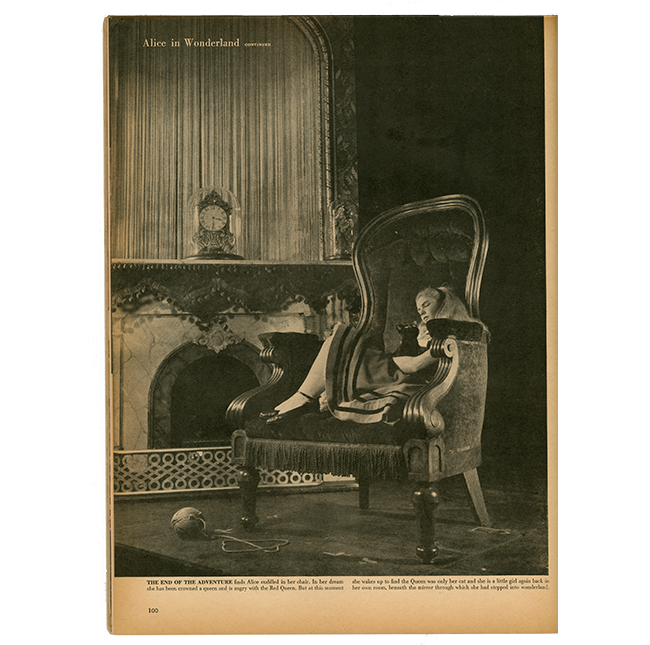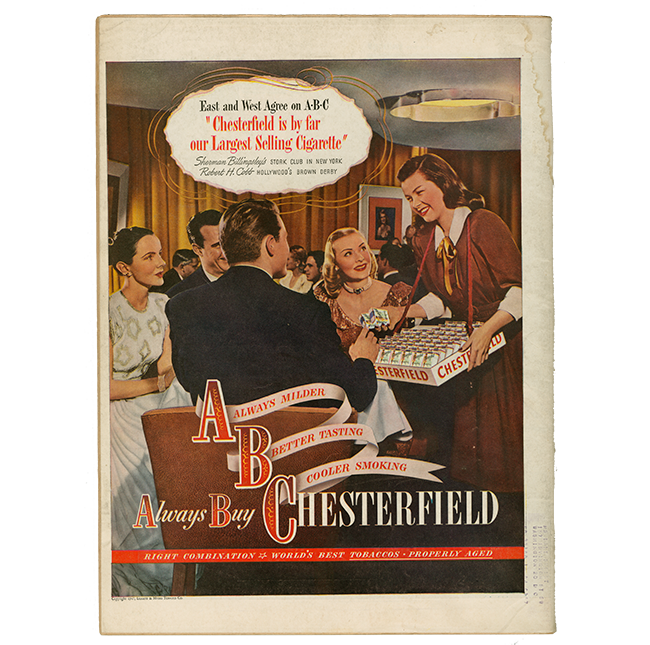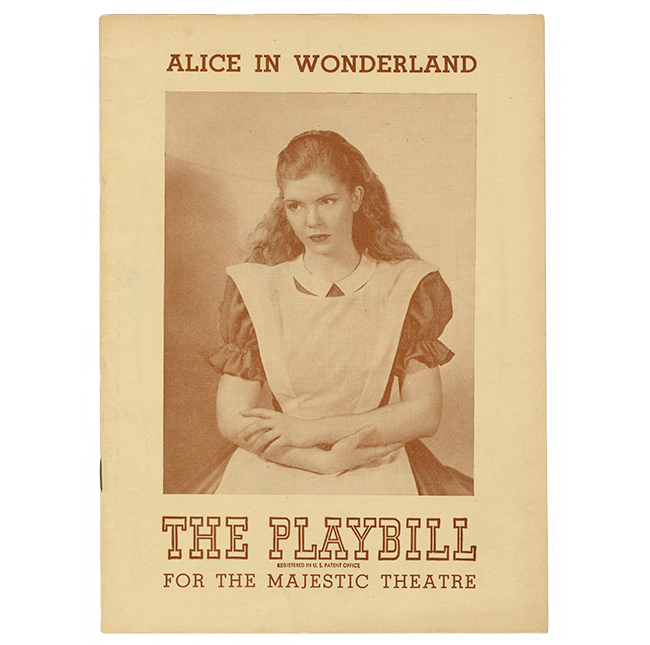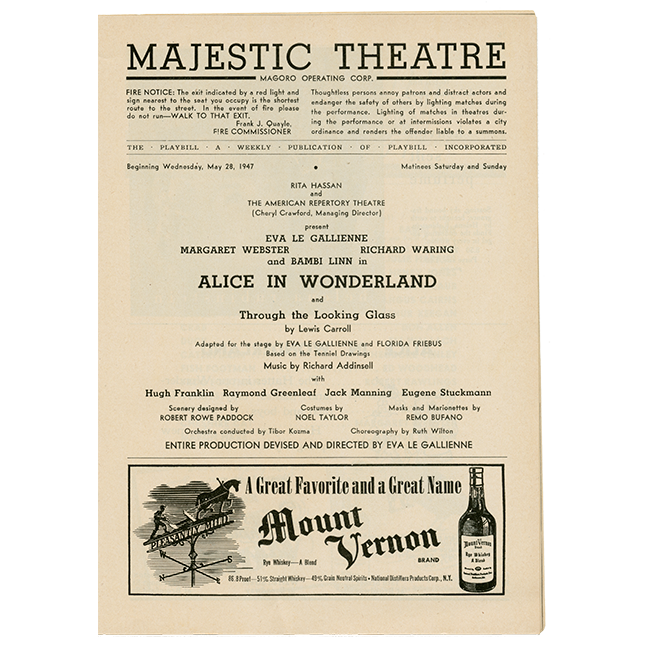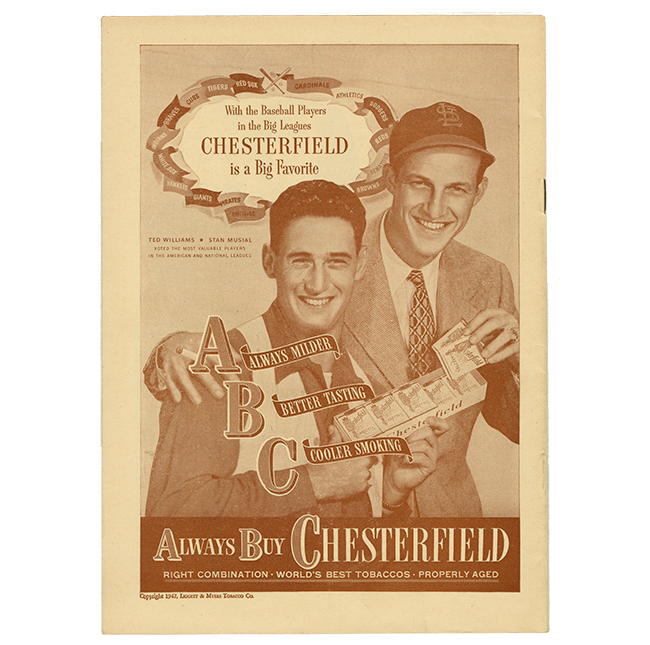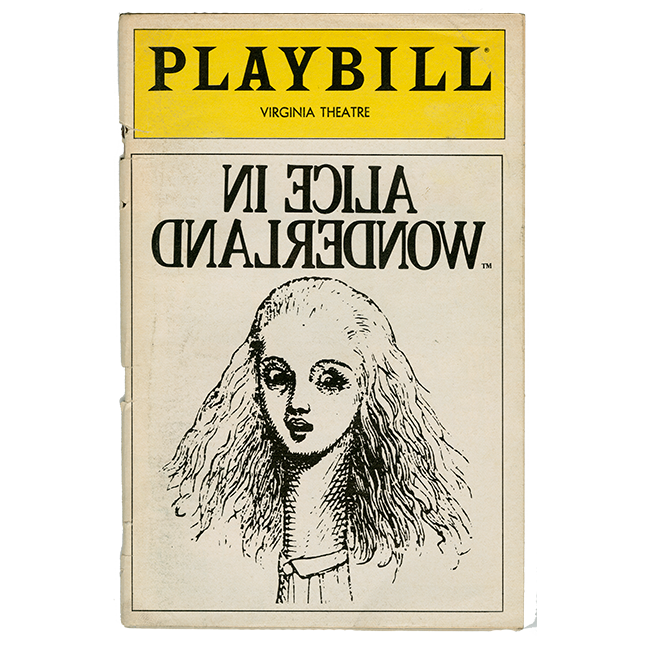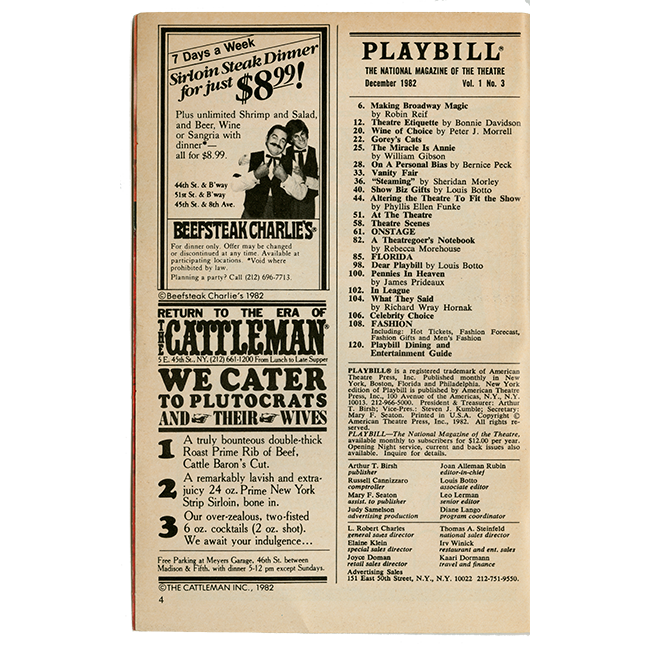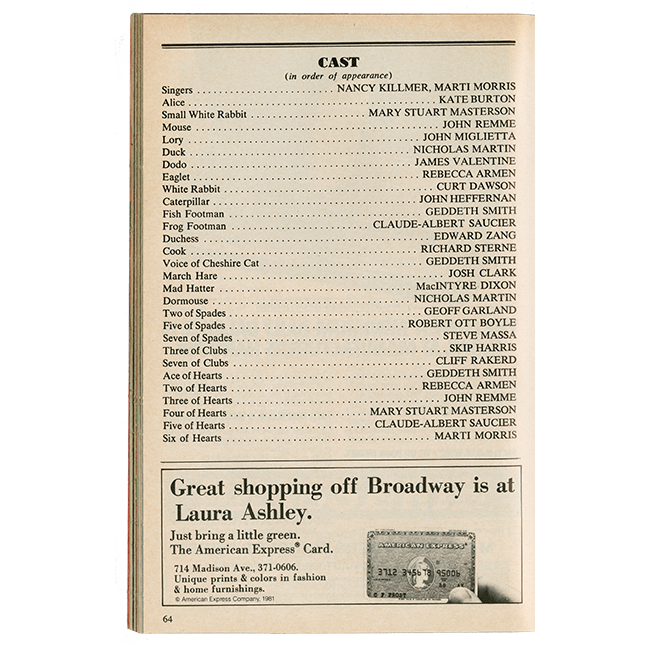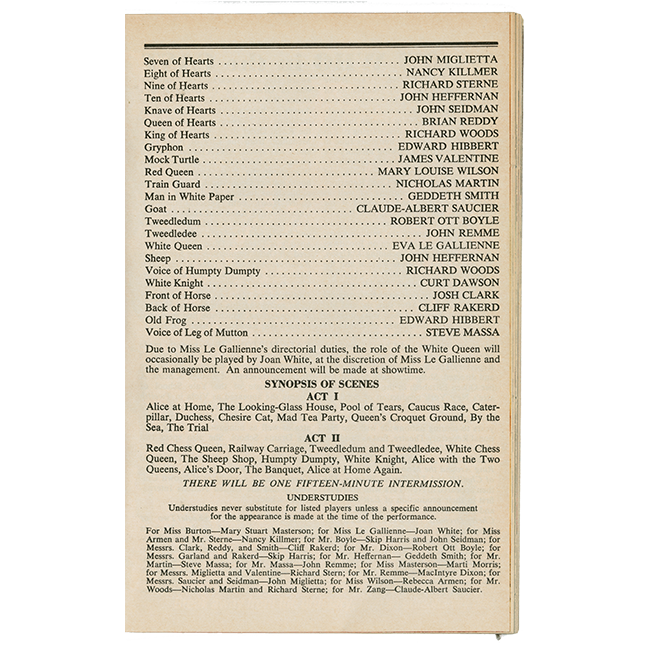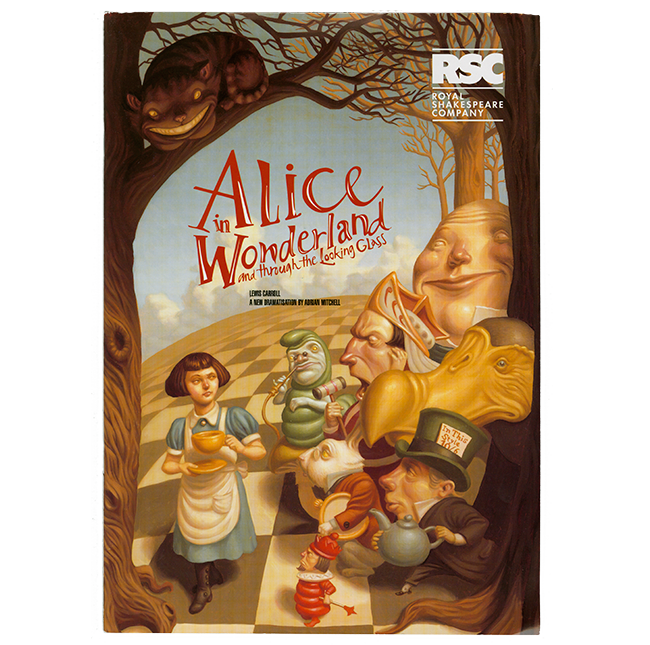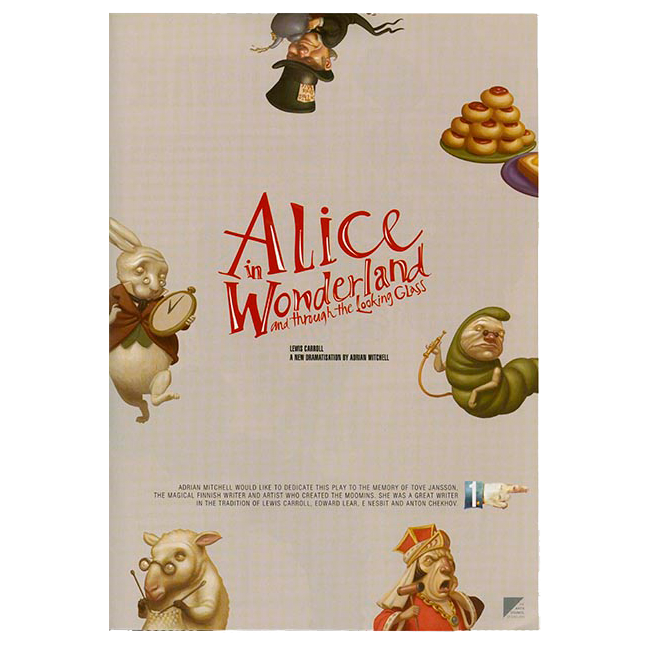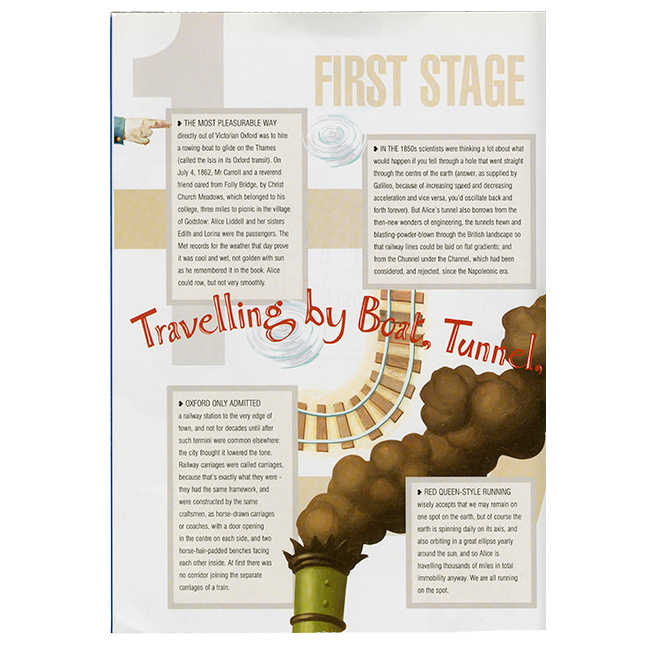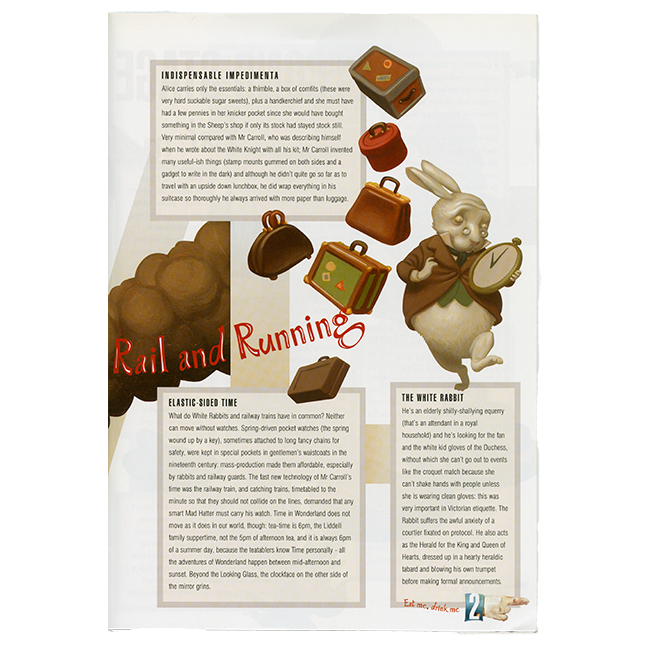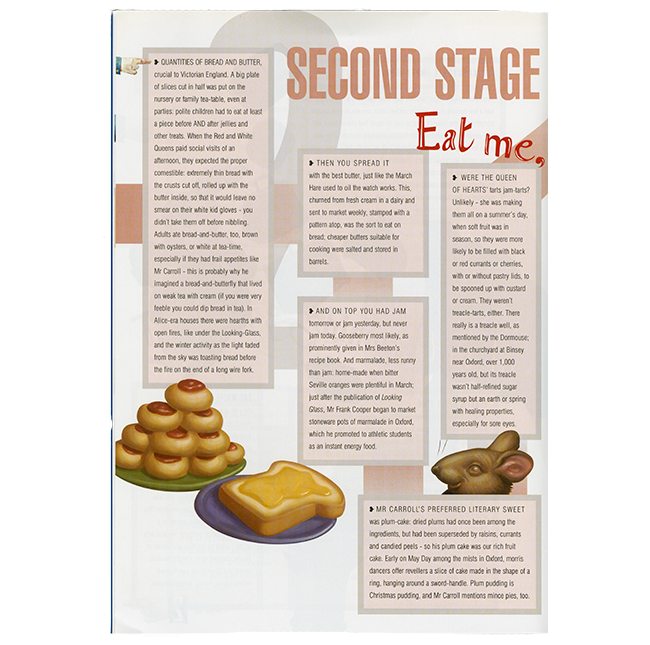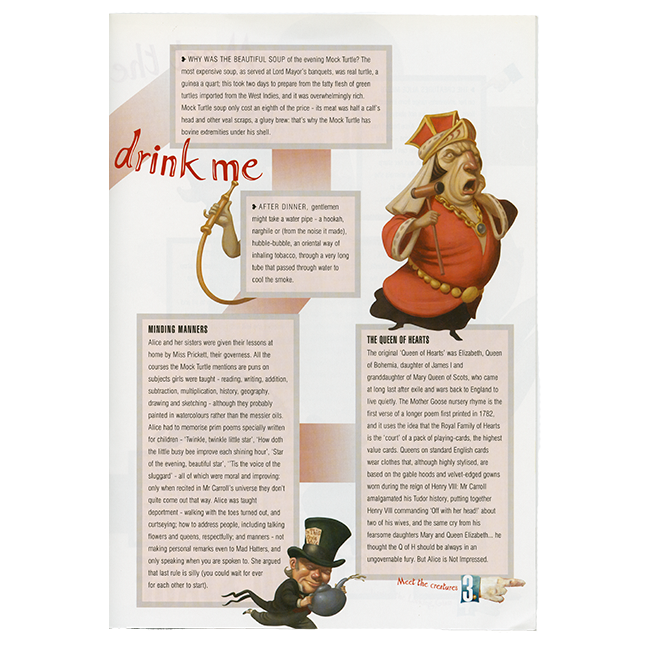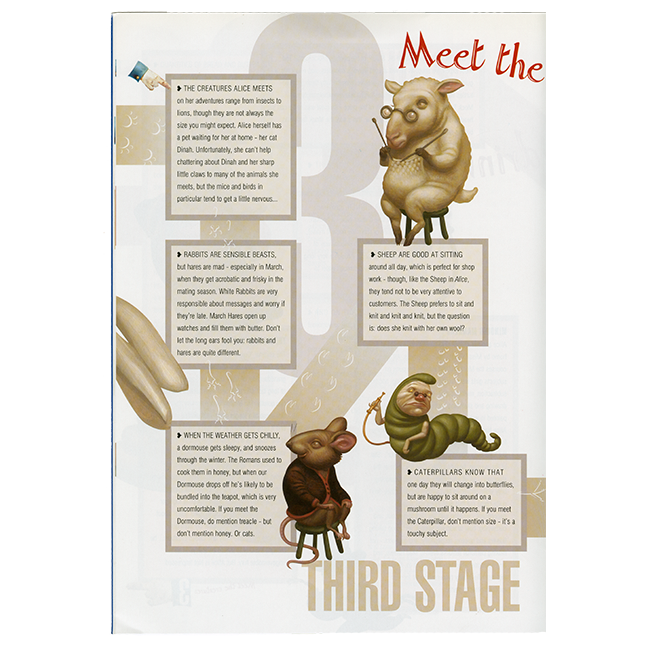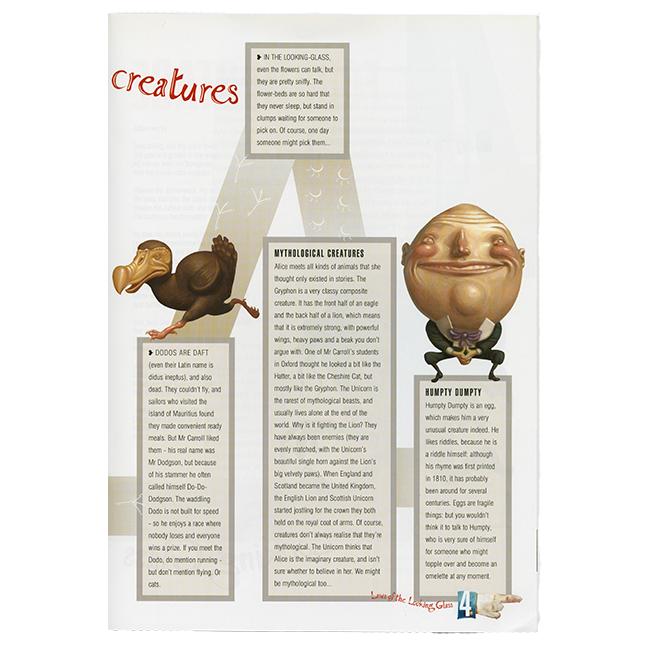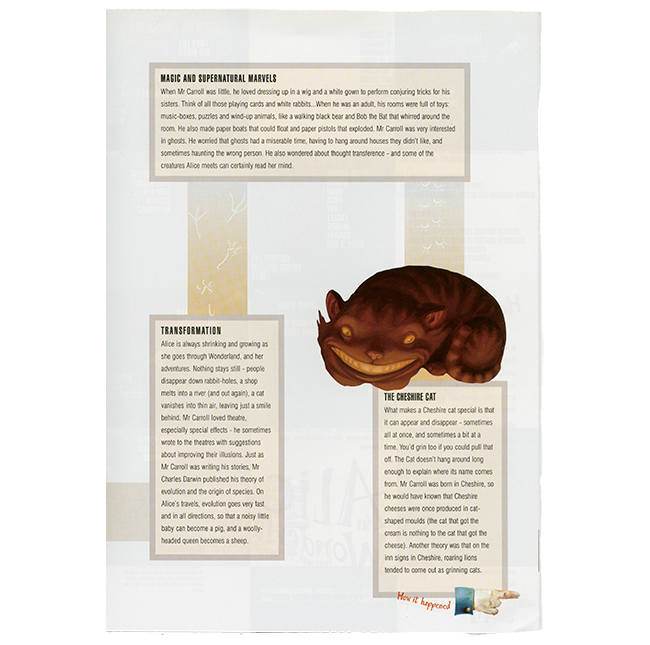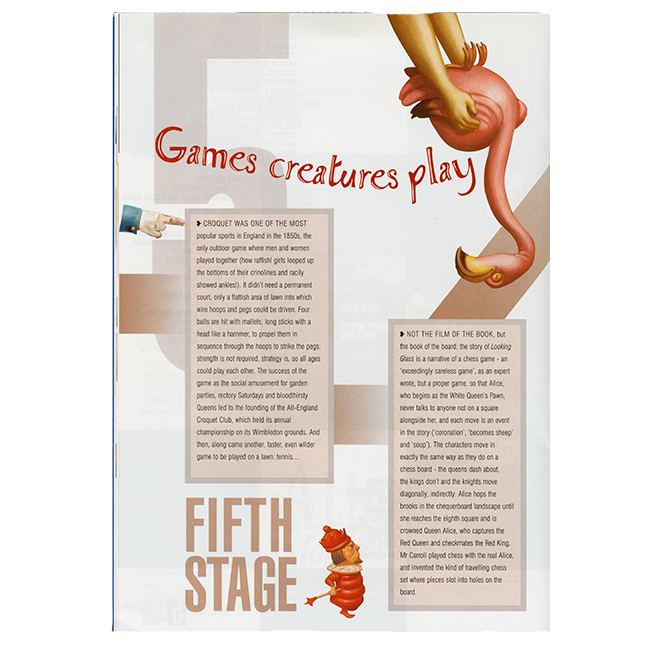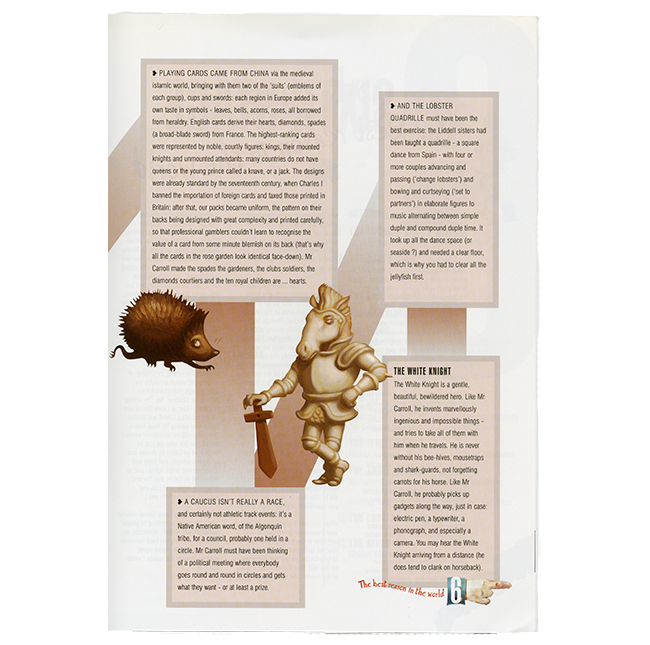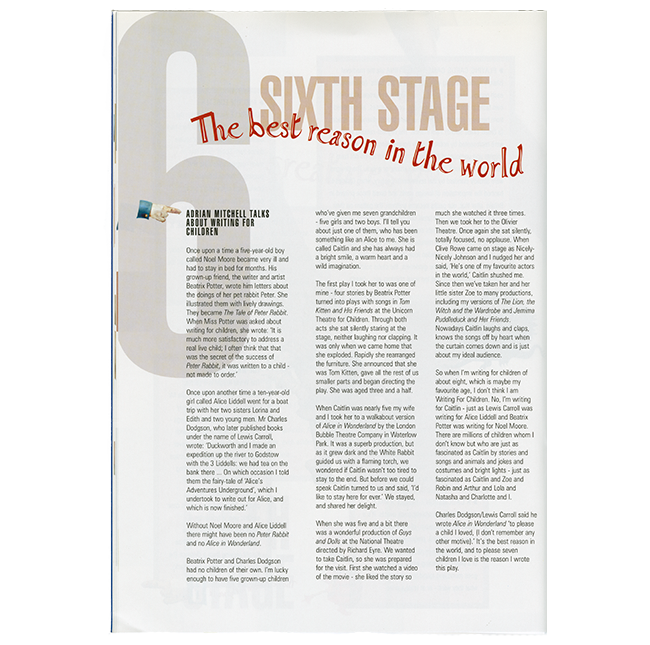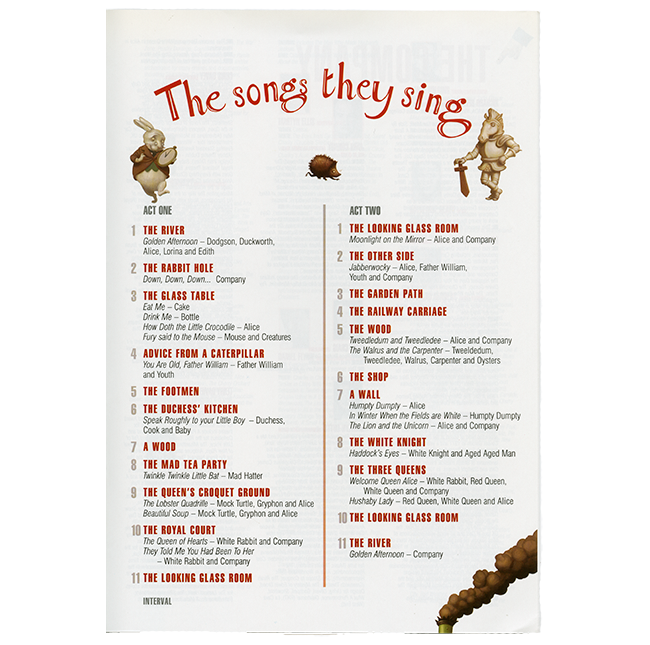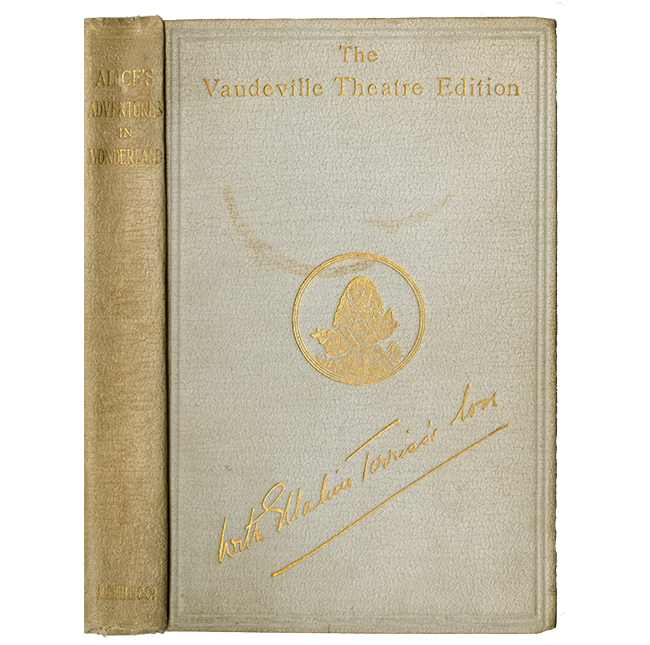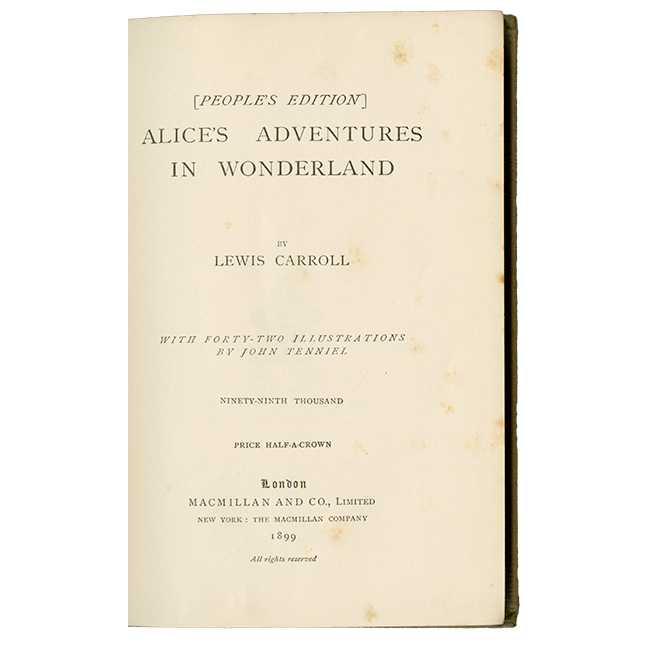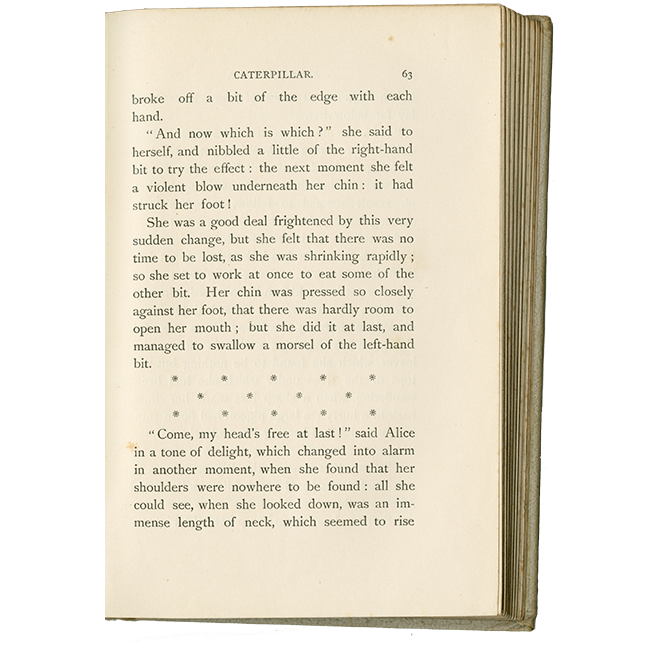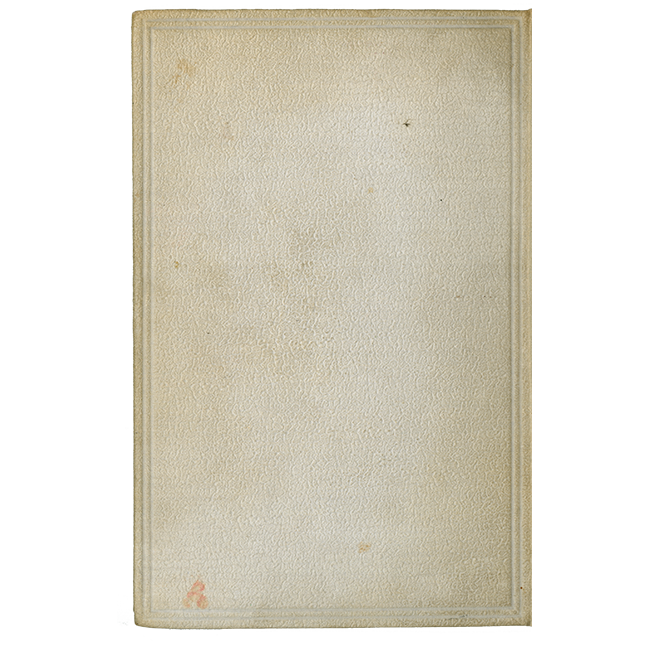Theatre
Alice in Wonderland Operetta
Alice in Wonderland, Continued, An Operetta in Two Acts.
Playbill.
Book by Rebecca L. Hooper. Music by Mabel W. Daniels.
Montclair City Hall, [New Jersey], April 19-21, circa 1905.
This is an early adaptation, one of literally thousands that have been undertaken by amateur school and community groups around the world. From the author’s note:
Alice, proud of her early adventures in Wonderland, runs away from the Hatter’s Boarding School, where he educates the girls by means of phonographs, and comes back to Wonderland because she wants a career, and it is the purpose of the Hatter’s ambition to crush all originality in girls.
The plot continues in an hilarious and twisting fashion, until all ends well, with several marriages among Wonderland characters, and some conversions to feminism. In this production, evidently performed at a girls’ boarding school, all the parts are taken by girls, with the Hatter being played by Rebecca Lane Hooper (1877–1937), the librettist. Hooper was an American suffragist, journalist, and writer. She married William Franklin Eastman in 1912 and was published widely under her married name. Both she and composer Mabel Wheeler Daniels (1877–1971) were 1900 graduates of Radcliffe College. The operetta was evidently performed several times between 1904 and 1910.
Exhibit item 9.17
Manhattan Project Production
Alice in Wonderland. The Forming of a Company and the Making of a Play.
Text by Doon Arbus. Photographs by Richard Avedon.
New York: Merlin House, 1973.
The text of this book is a collective account by the members of the Manhattan Project, a theatrical company formed in 1968 by the brilliant actor and director, Andre Gregory (1934– ), of the 2-year development of the avant-garde play Alice in Wonderland directed by Gregory. The book tells “of the forming of a company, the way Alice in Wonderland was chosen, and how it was made into a play.” “Go read,” Gregory told his six actors, and “The essential thing is to use the script as a trampoline for the imagination.”
The book presents numerous full-page black and white studio photographs by Richard Avedon documenting the actors’ amazing physical feats. Time Magazine’s review (October 26, 1970) called the play “an exciting, absorbing, vertiginous descent into a laughing hell” in which “the playgoer encounters states of dread, of sexuality, of absurdity, of bewilderment, of wonder, of fear, of giddiness, of giggliness, of madness, of contraction, of elevation, of ‘growing pains,’ of terror, of playfulness, of ecstasy.” (Sounds like Alice in Wonderland!)
Todd London, in American Theatre (March 2005) described Avedon’s book as:
Inarguably, the finest collection of photos of a single production in the history of the American theatre. They capture everything…the momentum, wildness, joy, acrobatic daring, ensemble verve and edgy emotional volatility—the great delinquent lunacy of it all…The caterpillar smokes his hookah on the backs of four actors who form a mushroom. Humpty Dumpty, an egg smashed on his face, falls from a tower of chairs. And a crazy-ass tea party happens over, under and all around a ravaged wooden table.
Exhibit item 9.5
Isa Bowman
The Sisters Bowman Nellie, Empsie, Isa, and Maggie.
Postcard.
London: J. Beagles and Co., circa 1905.
All four Bowman sisters were actors, and all were friends of Carroll’s but he was particularly fond of Isa (1874–1958), whom he first encountered when she played an oyster-ghost in the 1886–87 production of Henry Savile-Clarke’s Alice in Wonderland musical play. (There are no oyster-ghosts in the original story, but Savile-Clarke invented them, and Carroll approved.)
He was so struck by Isa that he arranged a meeting, and soon invited her to visit him at his summer lodgings in Eastbourne. Carroll then recommended that Isa play the lead in the 1888 revival of Savile-Clarke’s play. Isa later wrote a book about him, The Story of Lewis Carroll, Told for Young People by the Real Alice in Wonderland. Despite her claim, she was not the real Alice—all her writings tended toward exaggeration. There is a note on the back of this postcard pointing out Isa (upper right).
Exhibit item 9.11
Children's Play
Alice in Wonderland: A Play for Children in Three Acts.
Dramatized by Mrs. Burton Harrison with Tableaux Songs and Dances.
Illustrated by John Tenniel.
Chicago and New York: The Dramatic Publishing Co., © 1890.
A teachers’ handbook of the period described Mrs.’ Harrison’s play thus:
“Thirty-odd characters, most of whom may be either male or female; settings, two exteriors and one interior; costumes, fanciful, as demanded by the story; time, a short evening. This is an excellent dramatization of the well-known story. It may be altered in many minor ways to suit conditions.
Lewis Carroll had a copy of this play, one of three dramatic versions he owned, according to a letter he wrote in 1895. Mrs. Burton Harrison (1843–1920) was a prolific American writer. Her first writings, newspaper pieces published in Richmond during the civil war, were signed with the nom de plume, “Refugitta.”
Exhibit item 9.12
Merrymount Press
Alice in Wonderland: A Play / Compiled from Lewis Carroll’s stories Alice in Wonderland and Through the Looking-Glass and What Alice Found There.
By Emily Prime Delafield.
New York: Dodd, Mead and Company 1898.
Printed by D. B. Updike at the Merrymount Press.
First Edition. The arts and crafts style illustrations and the covers are by Bertram Grosvenor Goodhue (1869–1924), well-known for book design, type design, and illustration, but primarily as an architect. The plates are in two colors, red and black, the covers in full color.
In her preface, Delafield tells how she was inspired by an amateur children’s performance of Alice which she saw in Yokohama, Japan, in April 1890. Her play, written in seven acts, was performed in March 1897 by about 60 children aged 4-12 at the original Waldorf Hotel, which was demolished in 1929 to make way for the Empire State Building. Delafield reports that the scene where the Dormouse is stuffed into the teapot brought down the house.
Exhibit item 9.18
Life Magazine
Alice in Wonderland: Lewis Carroll’s Story Makes a Charming Play with Bambi Linn as Heroine.
Life Magazine.
April 28, 1947.
The cover photo of Alice (actress Bambi Linn) and Humpty Dumpty by the renowned photographer Phillipe Halsman (1906–79) is from the American Repertory Theatre production of Alice in Wonderland, directed by Eva Le Gallienne. Halsman also has one interior photograph of Alice; the others are by Eileen Darby (1916–2004), famous for her photographs of theatrical productions. According to Life, Bambi Linn “looks just the way Lewis Carroll’s Alice should look. She also acts the way Alice should.” In 1958, a poll conducted by Popular Photography named Latvian-born Halsman one of the "World's Ten Greatest Photographers."
Exhibit item 9.15
Majestic Playbill
Alice in Wonderland. The Playbill for the Majestic Theatre.
Playbill for the American Repertory Theatre production of Wonderland and Looking Glass beginning May 28, 1947
. Adapted by Eva Le Gallienne and Florida Friebus.
Music by Richard Addinsell.
On the cover is a sepia photo of Bambi Linn (born Bambina Linnemeir, 1926– ) in an “Alice” pinafore. This play, which has elements from both Wonderland and Looking Glass, had originally been produced in 1932 at Le Gallienne’s Civic Repertory Theatre. This revival opened at the International Theatre, Columbus Circle, on April 21, 1947, but soon moved to the Majestic, the premiere musical theatre in New York. It would be revived again in 1982.
Le Gallienne herself played the White Queen in all three productions. Playwright Florida Friebus said that the dialogue, scenery, and costumes were absolutely true to Carroll and Tenniel. (Friebus wrote it, but it was overhauled by Le Gallienne.) One of the ads in this program, for the Rogers Peet company, states: “The Hatter in our Wonderland makes only hats for men and boys”.
Exhibit item 9.14
Virginia Playbill
Alice in Wonderland [in mirror writing].
Playbill. Virginia Theatre.
December 1982.
The Eva Le Gallienne / Florida Friebus production was revived at the Virginia Theatre in 1982 with the 83-year-old Le Gallienne still playing the White Queen (and still “flying” in on a wire in the second act!) and 25-year-old Kate Burton (1957– ) as Alice. The pig, “Hamleta,” won her role in an open “pig audition” on November 23, 1982, at age nine days.
The play bombed—it ran from only Dec 23, 1982 to Jan 9, 1983, despite its success twice before. The theatre world had changed and the play was now considered static and unoriginal. However, it was revived more successfully the next year as a PBS Great Performances special, with a truly all-star cast: Eve Arden, Kaye Ballard, James Coco, Colleen Dewhurst, Andre Gregory, Geoffrey Holder, Nathan Lane, Donald O’Connor, Maureen Stapleton( replacing Le Gallienne), and Kate’s father, Richard Burton. This playbill includes some Edward Gorey illustrations of cats from the musical “Cats.”
Exhibit item 9.16
Royal Shakespeare Company
Alice in Wonderland and Through the Looking Glass.
Program.
Royal Shakespeare Theatre, 2001.
. The Royal Shakespeare Company had been experiencing a rough and bumpy 2001 and hoped this family-targeted adaptation of Wonderland and Looking-Glass, which it commissioned from Adrian Mitchell (1932–2008), might help them through the winter season, but the reviewers were not kind. The Guardian called it charmless. This program with its brilliant, but sadly uncredited, illustrations may have been the best thing about it.
The program contains lots of information bites about Carroll, Alice, etc., suitable for a young audience. David Jays, the editor, later wrote (Arts Journal weblog, January 13, 2009):
“For an adaptation of Alice in Wonderland (by the lovely poet and playwright Adrian Mitchell, who died at the end of last year), we set out the background information like a board game, carrying the reader from page to page with a grave playfulness that I must admit I would have loved when I was little.”
The play was performed at the Barbican in London October 29 to November 24, 2001, and then in Stratford-upon-Avon from November 30 to March 9, 2002.
Exhibit item 9.7
Vaudeville Alice
Alice’s Adventures in Wonderland.
London: Macmillan and Co., 1899.
Bound in white vellum with “The Vaudeville Theatre Edition” at the top, a roundel with Alice holding the pig baby in the center, and on a diagonal in the lower third of the cover “With Ellaline Terriss’s love,” all in gilt. Terriss (1871–1971) played Alice in Henry Savile Clarke’s staged Alice in Wonderland, which opened in a revival at London’s Vaudeville Theatre, on December 19, 1900.
This is a specially bound copy of Macmillan’s “People’s edition.” It is not known how many copies were thus bound; all known copies are dated 1899. (There were also cheaper “Six-Penny” Vaudeville editions, in paper wrappers, dated 1900.) The Vaudeville editions were probably sold in the theatre lobby. Drama critic Max Beerbohm liked everything about the play except Ellaline Terris, whom he found too old for the part, while trying too hard to look younger. (Alice had almost always been played by a child or teenager in earlier productions.)
Exhibit item 9.2

